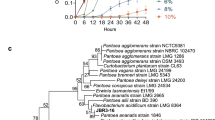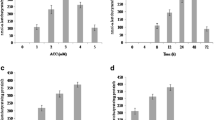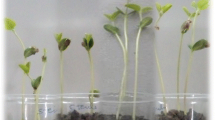Abstract
Purpose
The present study was conducted to elucidate the role of phytobeneficial bacteria to control the cellular oxidative damage in maize (Zea mays L.) plants caused by salinity.
Methods
Bacteria were isolated from the rhizosphere of kallar grass (Leptochloa fusca L.) through serial dilution method and taxonomically identified on the basis of their 16S ribosomal RNA gene sequencing. In vitro phosphate solubilization, indole-3-acetic acid (IAA) synthesis, and 1-aminocyclopropane-1-carboxylic acid (ACC) deaminase activity were evaluated by solubilization index measurement, colorimetric method, and turbidity assay, respectively. In the pot experiment, the impact of single and mixed inoculation of these strains at four levels (0, 50, 100, and 200 mM) of salt stress was evaluated in terms of growth and physiological response of maize plants to salinity.
Results
The bacterial strains (STN-1, STN-5, and STN-14) were taxonomically classified as Staphylococcus spp. At 5% NaCl level, the strains demonstrated substantial potential for phosphate solubilization, ACC deaminase activity, and IAA production both with and without tryptophan. The inoculation of strains STN-1, STN-5, and mixed inoculation resulted in substantial growth improvement of maize plants along with increased antioxidant enzyme activity and decreased levels of reactive oxygen species. In addition, single inoculation of STN-1 and STN-5 along with mixed inoculation augmented the uptake of N, P, K, and Ca+2 and reduced Na+ uptake.
Conclusion
Current results demonstrated that the strains STN-1 and STN-5 modulated stress-responsive mechanisms and regulated ion balance in induced salinity to promote maize growth.




Similar content being viewed by others
References
Aebi H (1984) Catalase in vitro. Methods Enzymol Elsevier; p 121–126
Ahmad M, Zahir ZA, Jamil M, Nazli F, Latif M, Akhtar M (2014) Integrated use of plant growth promoting rhizobacteria, biogas slurry and chemical nitrogen for sustainable production of maize under salt-affected conditions. Pak J Bot 46(1):375–382
Akram MS, Shahid M, Tariq M, Azeem M, Javed MT, Saleem S, Riaz S (2016) Deciphering Staphylococcus sciuri SAT-17 mediated anti-oxidative defense mechanisms and growth modulations in salt stressed maize (Zea mays L.). Front Microbiol 7:867
Alibrandi P, Cardinale M, Rahman MM, Strati F, Ciná P, de Viana ML, Giamminola EM, Gallo G, Schnell S, De Filippo C (2018) The seed endosphere of Anadenanthera colubrina is inhabited by a complex microbiota, including Methylobacterium spp. and Staphylococcus spp. with potential plant-growth promoting activities. Plant Soil 422(1–2):81–99
Arnon D, Hoagland D (1940) Crop production in artificial culture solutions and in soils with special reference to factors influencing yields and absorption of inorganic nutrients. Soil Sci 50:463–485
Babalola OO (2010) Beneficial bacteria of agricultural importance. Biotechnol Lett 32(11):1559–1570
Bates L, Waldren R, Teare I (1973) Rapid determination of free proline for water-stress studies. Plant Soil 39(1):205–207
Bradford MM (1976) A rapid and sensative method for the quantitation of microgram quantities of protein utilizing the principle of protein–dye binding. Ann Biochem 72:248–254
Cha-Um S, Kirdmanee C (2009) Effect of salt stress on proline accumulation, photosynthetic ability and growth characters in two maize cultivars. Pak J Bot 41(1):87–98
Chance B, Maehly A (1955) Assay of catalases and peroxidases. Methods Enzymol 2:764–775
Cheng Z, Woody OZ, McConkey BJ, Glick BR (2012) Combined effects of the plant growth-promoting bacterium Pseudomonas putida UW4 and salinity stress on the Brassica napus proteome. Appl Soil Ecol 61:255–263
Compant S, Duffy B, Nowak J, Clément C, Barka EA (2005) Use of plant growth-promoting bacteria for biocontrol of plant diseases: principles, mechanisms of action, and future prospects. Appl Environ Microbiol 71(9):4951–4959
Couillerot O, Combes-Meynet E, Pothier JF, Bellvert F, Challita E, Poirier M-A, Rohr R, Comte G, Moënne-Loccoz Y, Prigent-Combaret C (2011) The role of the antimicrobial compound 2, 4-diacetylphloroglucinol in the impact of biocontrol Pseudomonas fluorescens F113 on Azospirillum brasilense phytostimulators. Microbiol 157(6):1694–1705
Curá JA, Franz DR, Filosofía JE, Balestrasse KB, Burgueño LE (2017) Inoculation with Azospirillum sp. and Herbaspirillum sp. bacteria increases the tolerance of maize to drought stress. Microorganisms 5(3):41
Dimkpa C, Weinand T, Asch F (2009) Plant–rhizobacteria interactions alleviate abiotic stress conditions. Plant Cell Environ 32(12):1682–1694
Dobbelaere S, Vanderleyden J, Okon Y (2003) Plant growth-promoting effects of diazotrophs in the rhizosphere. Crit Rev Plant Sci 22(2):107–149
Etesami H, Beattie GA (2018) Mining halophytes for plant growth-promoting halotolerant bacteria to enhance the salinity tolerance of non-halophytic crops. Front Microbiol 9:148
Forni C, Duca D, Glick BR (2017) Mechanisms of plant response to salt and drought stress and their alteration by rhizobacteria. Plant Soil 410(1–2):335–356
Gerhardt P, Murray RGE, Costilow RN, Nester EW, Wood WA, Krieg NR, Phillips GB (1981) Manual of methods for general bacteriology. American Society for Microbiology, Washington, DC ISBN 0-914826-30-1
Glick BR (2014) Bacteria with ACC deaminase can promote plant growth and help to feed the world. Microbiol Res 169(1):30–39
Gordon SA, Weber RP (1951) Colorimetric estimation of indoleacetic acid. Plant Physiol 26(1):192–195
Hamdia MAE-S, Shaddad M, Doaa MM (2004) Mechanisms of salt tolerance and interactive effects of Azospirillum brasilense inoculation on maize cultivars grown under salt stress conditions. Plant Growth Regul 44(2):165–174
Harrigan WF, McCance ME (1990) Laboratory methods and food and dairy microbiology. Academic Press, London
Heath RL, Packer L (1968) Photoperoxidation in isolated chloroplasts: I. Kinetics and stoichiometry of fatty acid peroxidation. Arch Biochem Biophys 125(1):189–198
Heydarian Z, Yu M, Gruber M, Glick BR, Zhou R, Hegedus DD (2016) Inoculation of soil with plant growth promoting bacteria producing 1-aminocyclopropane-1-carboxylate deaminase or expression of the corresponding acdS gene in transgenic plants increases salinity tolerance in Camelina sativa. Front Microbiol 7:1966
Ilangumaran G, Smith DL (2017) Plant growth promoting rhizobacteria in amelioration of salinity stress: a systems biology perspective. Front Plant Sci 8:1768
Jana S, Choudhuri MA (1982) Glycolate metabolism of three submersed aquatic angiosperms during ageing. Aquat Bot 12:345–354
Julkunen-Tiitto R (1985) Phenolic constituents in the leaves of northern willows: methods for the analysis of certain phenolics. J Agric Food Chem 33(2):213–217
Kashyap AS, Pandey VK, Manzar N, Kannojia P, Singh UB, Sharma P (2017) Role of plant growth-promoting rhizobacteria for improving crop productivity in sustainable agriculture. Plant-Microbe Interactions in Agro-Ecological Perspectives Springer; pp 673–693
Khan MU, Sessitsch A, Harris M, Fatima K, Imran A, Arslan M, Shabir G, Khan QM, Afzal M (2015) Cr-resistant rhizo- and endophytic bacteria associated with Prosopis juliflora and their potential as phytoremediation enhancing agents in metal-degraded soils. Front Plant Sci 5:755
Kim K, Jang Y-J, Lee S-M, Oh B-T, Chae J-C, Lee K-J (2014) Alleviation of salt stress by Enterobacter sp. EJ01 in tomato and Arabidopsis is accompanied by up-regulation of conserved salinity responsive factors in plants. Mol Cell 37(2):109
Kumar A, Bahadur I, Maurya B, Raghuwanshi R, Meena V, Singh D, Dixit J (2015) Does a plant growth promoting rhizobacteria enhance agricultural sustainability. J Pure Appl Microbiol 9(1):715–724
Kumar R, Goyal V, Kuhad M (2005) Influence of fertility–salinity interactions on growth, water status and yield of Indian mustard (Brassica juncea). Indian J Plant Physiol 10(2):139
Liu M, Chen Y, Chen Y, Shin JH, Mila I, Audran C, Zouine M, Pirrello J, Bouzayen M (2018) The tomato ethylene response factor Sl-ERF. B3 integrates ethylene and auxin signaling via direct regulation of Sl-aux/IAA 27. New Phytol 9(2):631–640
Mahmood F, Shahid M, Hussain S, Shahzad T, Tahir M, Ijaz M, Hussain A, Mahmood K, Imran M, Babar SAK (2017) Potential plant growth-promoting strain Bacillus sp. SR-2-1/1 decolorized azo dyes through NADH-ubiquinone: oxidoreductase activity. Bioresour Technol 235:176–184
Maniatis T, Fritsch EF, Sambrook J (1982) Molecular cloning: a laboratory manual, vol 545. Cold Spring Harbor Laboratory, Cold Spring Harbor, NY
Mayak S, Tirosh T, Glick BR (2004) Plant growth-promoting bacteria confer resistance in tomato plants to salt stress. Plant Physiol Biochem 42(6):565–572
Meena VS, Meena SK, Verma JP, Kumar A, Aeron A, Mishra PK, Bisht JK, Pattanayak A, Naveed M, Dotaniya M (2017) Plant beneficial rhizospheric microorganism (PBRM) strategies to improve nutrients use efficiency: a review. Ecol Eng 107:8–32
Nasraoui-Hajaji A, Gouia H, Carrayol E, Haouari-Chaffei C (2012) Ammonium alleviates redox state in Solanum seedlings under cadmium stress conditions. J Environ Anal Toxicol 2:116–120
Nemeghaire S, Argudín MA, Feßler AT, Hauschild T, Schwarz S, Butaye P (2014) The ecological importance of the Staphylococcus sciuri species group as a reservoir for resistance and virulence genes. Vet Microbiol 171(3–4):342–356
Ola HAE, Reham EF, Eisa S, Habib S (2012) Morpho-anatomical changes in salt stressed kallar grass (Leptochloa fusca L. Kunth). Res J Agric Biol Sci 8(2):158–166
Panda SK, Baluška F, Matsumoto H (2009) Aluminum stress signaling in plants. Plant Signal Behav 4(7):592–597
Penrose DM, Glick BR (2003) Methods for isolating and characterizing ACC deaminase-containing plant growth-promoting rhizobacteria. Physiol Plant 118:10–15
Pikovskaya R (1948) Mobilization of phosphorus in soil in connection with vital activity of some microbial species. Mikrobiologiya 17:362–370
Prithiviraj B, Bais HP, Jha AK, Vivanco JM (2005) Staphylococcus aureus pathogenicity on Arabidopsis thaliana is mediated either by a direct effect of salicylic acid on the pathogen or by SA-dependent, NPR1-independent host responses. Plant J 42(3):417–432
Qureshi AS, McCornick PG, Qadir M, Aslam Z (2008) Managing salinity and waterlogging in the Indus Basin of Pakistan. Agric Water Manag 95(1):1–10
Rahneshan Z, Nasibi F, Moghadam AA (2018) Effects of salinity stress on some growth, physiological, biochemical parameters and nutrients in two pistachio (Pistacia vera L.) rootstocks. J Plant Interact 13(1):73–82
Roohi A, Ahmed I, Iqbal M, Jamil M (2012) Preliminary isolation and characterization of halotolerant and halophilic bacteria from salt mines of Karak, Pakistan. Pak J Bot 44(SI 1):365–370
Ryan J, Estefan G, Rashid, A (2007) Soil and plant analysis laboratory manual. ICARDA
Sahoo RK, Ansari MW, Pradhan M, Dangar TK, Mohanty S, Tuteja N (2014) A novel Azotobacter vinellandii (SRI Az 3) functions in salinity stress tolerance in rice. Plant Signal Behav 9(7):511–523
Shahbaz M, Ashraf M (2013) Improving salinity tolerance in cereals. Crit Rev Plant Sci 32(4):237–249
Shahid M, Akram MS, Khan MA, Zubair M, Shah SM, Ismail M, Not Shabir G, Basheer S, Aslam K, Tariq M (2018) A phytobeneficial strain Planomicrobium sp. MSSA-10 triggered oxidative stress responsive mechanisms and regulated the growth of pea plants under induced saline environment. J Appl Microbiol 124(6):1566–1579
Shahid M, Hameed S, Imran A, Ali S, van Elsas JD (2012) Root colonization and growth promotion of sunflower (Helianthus annuus L.) by phosphate solubilizing Enterobacter sp. Fs-11. World J Microbiol Biotechnol 28(8):2749–2758
Shahid M, Hameed S, Tariq M, Zafar M, Ali A, Ahmad N (2015) Characterization of mineral phosphate-solubilizing bacteria for enhanced sunflower growth and yield-attributing traits. Ann Microbiol 65(3):1525–1536
Shahid M, Hussain B, Riaz D, Khurshid M, Ismail M, Tariq M (2017) Identification and partial characterization of potential probiotic lactic acid bacteria in freshwater Labeo rohita and Cirrhinus mrigala. Aquac Res 48(4):1688–1698
Shrivastava P, Kumar R (2015) Soil salinity: a serious environmental issue and plant growth promoting bacteria as one of the tools for its alleviation. Saudi J Biol Sci 22(2):123–131
Shukla PS, Agarwal PK, Jha B (2012) Improved salinity tolerance of Arachis hypogaea (L.) by the interaction of halotolerant plant-growth-promoting rhizobacteria. J Plant Growth Regul 31(2):195–206
Somasegaran P, Hoben HJ (1994) Handbook for rhizobia: methods in legume-rhizobium technology. Springer Science & Business Media
Spaepen S, Vanderleyden J (2011) Auxin and plant–microbe interactions. Cold Spring Harb Perspect Biol 3(4):a001438
Steel R, Torrie J, Dickey DA (1997) Principles and procedures of statistics: a biometrical approach. McGraw-Hill
Sun H, Mu B, Song Z, Ma Z, Mu T (2018) The in vitro antioxidant activity and inhibition of intracellular reactive oxygen species of sweet potato leaf polyphenols. Oxidative Med Cell Longev 2018:11
Waszczak C, Carmody M, Kangasjärvi J (2018) Reactive oxygen species in plant signaling. Annu Rev Plant Biol 69:209–236
Weisburg WG, Barns SM, Pelletier DA, Lane DJ (1991) 16S ribosomal DNA amplification for phylogenetic study. J Bacteriol 173(2):697–703
Wolf B (1982) A comprehensive system of leaf analyses and its use for diagnosing crop nutrient status. Commun Soil Sci Plant Anal 13:1035–1059. https://doi.org/10.1080/00103628209367332
Yildrim E, Donmez MF, Turan M (2008) Use of bioinoculants in ameliorative effects on radish plants under salinity stress. J Plant Nutr 31(12):2059–2074
Younesi O, Moradi A (2014) Effects of plant growth-promoting rhizobacterium (PGPR) and arbuscular mycorrhizal fungus (AMF) on antioxidant enzyme activities in salt-stressed bean (Phaseolus vulgaris L.). Agric 60(1):10–21
Zafar S, Ashraf MY, Anwar S, Ali Q, Noman A (2016) Yield enhancement in wheat by soil and foliar fertilization of K and Zn under saline environment. Soil Environ 35(1):46–55
Zhang H, Kim M-S, Sun Y, Dowd SE, Shi H, Paré PW (2008) Soil bacteria confer plant salt tolerance by tissue-specific regulation of the sodium transporter HKT1. Mol Plant-Microbe Interact 21(6):737–744
Funding
This research work was funded by GCUF-RSP research grant (project no. 38-B&B-15) entitled “Development of salt-tolerant biofertilizer for saline agriculture in Pakistan.”
Author information
Authors and Affiliations
Corresponding author
Ethics declarations
Conflict of interest
The authors declare that they have no conflict of interest.
Ethical approval
This article does not contain any studies with human participants or animals performed by any of the authors.
Informed consent
Informed consent was obtained from all individual participants included in the study.
Additional information
Publisher’s note
Springer Nature remains neutral with regard to jurisdictional claims in published maps and institutional affiliations.
Electronic supplementary material
ESM 1
(JPG 1178 kb)
Rights and permissions
About this article
Cite this article
Shahid, M., Ahmed, T., Noman, M. et al. Non-pathogenic Staphylococcus strains augmented the maize growth through oxidative stress management and nutrient supply under induced salt stress. Ann Microbiol 69, 727–739 (2019). https://doi.org/10.1007/s13213-019-01464-9
Received:
Accepted:
Published:
Issue Date:
DOI: https://doi.org/10.1007/s13213-019-01464-9




